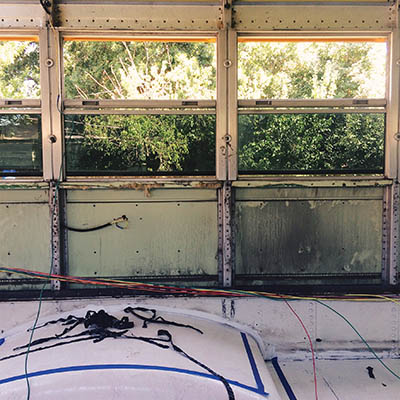Better, not bigger
Two Tulsans convert a Blue Bird school bus into a tiny home
Cheyenne Butcher and Blake Peters
Andria Whipple
The average size of a single family home in the U.S. has increased 50 percent since 1978, from 1,780 square feet to 2,662. Our nation has collectively eaten a lot of cheeseburgers, but surely not enough to necessitate that kind of expansion. Increased wealth and a culture of conspicuous consumption appear to be primary drivers.
The backlash against building bigger gained some ground in 1997 with architect Sarah Susanka’s The Not So Big House, which extolled building better, not bigger, and a return to housing under 1,000 square feet. The economic collapse a decade later began with the subprime mortgage crisis, which made living smaller a necessity for many.
The tiny house movement, building homes under 400 square feet, is becoming increasingly appealing for people looking for an alternative and more efficient lifestyle. Tulsans Cheyenne Butcher and Blake Peters had each been drawn to the idea before they met. Butcher is a local artist and photographer; Peters does commercial audio/visual installation.
“We liked the concept of living small and minimal,” Butcher said. “And having something that you built yourself.”
Searching online for inspiration to construct their tiny house, Peters found something else: a 2000 Blue Bird All American—a school bus—with 282,000 miles.
“The bus is actually from Bixby Schools,” he said. “They received bond money to buy new buses, so they were getting rid of this one.”
The mileage is low for a bus, and there’s 250-300 square feet of living space. The cost of their future home?
“$2,500,” Peters chuckled.
For them, preparing to downsize from their current 1,150-square-foot home was an easy decision.
“We get sentimental attachments to things that aren’t necessary,” Butcher said. “You don’t need to use all the money; you don’t need to use all the electricity on daily consumption.”
“You don’t really spend a lot of time in your house,” she said. “You sleep and you cook. We like camping and hiking. So really, wherever we go, that is our entertainment.”
 Making use of The School Bus Conversion Network (skoolie.net), a resource-sharing community of people working on similar projects, Butcher and Peters have found everything from basic conversion tutorials to tips for using alternative fuels like vegetable oil and biodiesel. They recently completed demolition on the bus, removing the seats, ceiling panels (a maddeningly grueling process, as anyone who follows them on Instagram has observed), insulation, flashers and stop signs.
Making use of The School Bus Conversion Network (skoolie.net), a resource-sharing community of people working on similar projects, Butcher and Peters have found everything from basic conversion tutorials to tips for using alternative fuels like vegetable oil and biodiesel. They recently completed demolition on the bus, removing the seats, ceiling panels (a maddeningly grueling process, as anyone who follows them on Instagram has observed), insulation, flashers and stop signs.
“The next step is probably going to be painting the outside,” Peters said. “It is illegal to have a yellow school bus. That shade of school bus yellow is not allowed.”
There’s quite a bit of work ahead—plumbing, electrical and a cooking space, among other installations—before their future home is street legal. They also plan to cover the roof in solar panels and install a small wood-burning stove for heat and a smaller propane water heater.
Their expected total costs for the home bus? You might want to sit down. Seriously, sit down.
“$10,000 to $12,000,” Peters said.
They anticipate it will take 8 more months to complete the project.
“It all depends on finances,” Butcher said. “It is fun, but it’s also hard work. And we just work on the weekends. Blake has a full-time job, and we made a deal to not work on the bus without the other person. We dedicate our Saturdays and Sundays to working on the bus.”
Butcher and Peters are logging their progress online. Read their tales of great ideas, busted tools, creative problem solving, victory and defeat at bluebirdadventure.wordpress.com, or follow the project on Instagram @bluebirdadventure.
When the project is complete, Peters and Butcher plan to travel the country with his dog and her cat. In addition selling handmade products online and dealing with the overwhelming everyday options of waking up by the beach/going surfing, Butcher plans to make a social documentary about people who have chosen minimal lifestyles. With the bus completion still months away, the other specifics have yet to be planned.
“Dreaming huge would be transporting it somehow on a barge to Europe and continuing our travels there,” Butcher said.
This is not just an acceptance of one lifestyle but a rejection of another.
“We’re just pouring our rent into the gas tank instead of giving it to somebody else,” Peters said.
“I love all the things being brought to Tulsa,” Butcher said. “Pershing School (see p. 22) is going to be amazing. But to be completely honest, for some [downtown developments], the starting prices are becoming outrageous for Tulsa. It’s like what I used to have when I lived in Chicago, but I can’t afford it. It’s getting more popular. I used to live in Denver on Capitol Hill, and it has doubled in price in the five years since I lived there. Every time I think about it I get angry.”
“But then I think, I’m building a ‘skoolie.’ I can build it to what I want it to be. Blake and I are putting our hard work into it. And we can take it anywhere we want.”
For more from the Voice's Spatial Recognition issue, read about Pershing Studios, a historic school building converted to non-traditional housing.
Want more stories from Andy? Read his interviews with cocktail expert Robert Simonson of The New York Times and filmmakers Christopher Long and Charles Elmore of Rough House Creative.


.jpg)
.jpg)
